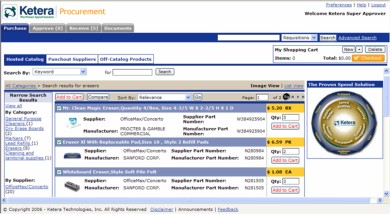The consumerization of enterprise applications

This is a phrase I seem to have been hearing non-stop during my trip to California, meeting with SaaS vendors or listening to presentations at SaaScon, which finished yesterday [see disclosure]. Ease of use is a big focus for on-demand SaaS vendors. Of course it is for conventional software vendors too, but they don't feel the need so keenly. A conventional on-premises vendor gets paid before implementation, before any users start using the application. An on-demand vendor gets paid when users are live, and has a strong incentive to make adoption as viral as possible. If they use a try-before-buy sales methodology, then they have even more incentive to design their applications to be self-evident and self-service.
Another factor here is user expectation, which I touched earlier this month in my item It's an on-demand world. Increasingly, users want their enterprise software to be as accessible as they experience when doing online banking, buying books from Amazon or posting to their personal blogs. I think all vendors are feeling this pressure, but on-demand vendors are in the forefront of responding to it.
On-demand spend management vendor Ketera is a good case in point. Ketera announced the new version of its software yesterday, and I was able to get a pre-briefing last week from CEO Burton Goldfield when I dropped by the company's offices in Santa Clara.

Ketera has completely overhauled its user interface to bring in all the best practice of self-service usability you can see in popular sites like Amazon.com. It's done it because its customers want their users to use the Ketera software whenever they purchase items. They don't want them going off and doing it in non-standard ways. One customer in particular prompted the redesign: the buyer had been set a target of having $300 million spend going through the application by the end of the calendar year.
Traditional spend management applications make it a chore to purchase anything through the corporate system. They replicate complex purchase requisition forms on-screen, making the whole process unnecessarily complicated. A great measurement of how effective Ketera's makeover has been is that a demonstration of making a purchase using the system — including the approvals process and the goods received process — takes just four-and-a-half minutes. Demonstrating exactly the same processes in the old system took 45 minutes — precisely ten times longer.
Yet all that Ketera has done is to take the corporate purchasing process and express it using an online retail purchasing metaphor. Buying products using Ketera is just like buying them using any online catalog. The company has simply adapted the best practice that's out there on the Web to its own application.
Another great measurement about Ketera's story is that this makeover was begun in March. To deliver such a huge change in the application in just six months is something else you don't get from conventional enterprise applications. Goldfield is a recent convert to the on-demand model, having worked for various enterprise software vendors until taking up his new post in May this year. He recognizes the challenge those vendors now face, having seen the kind of agility on-demand vendors can achieve: "I don't know how you keep up with that in an enterprise software model," he told me.